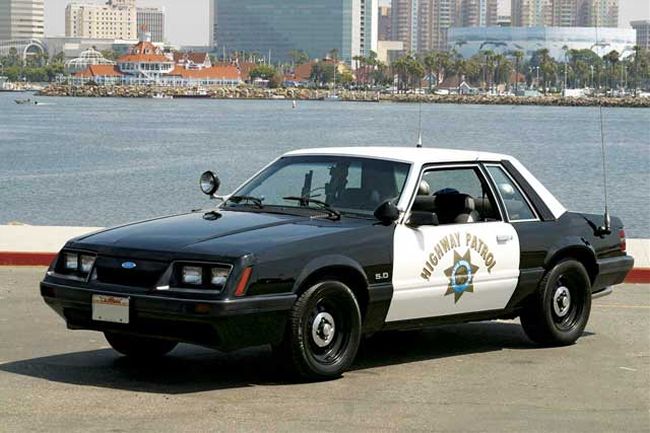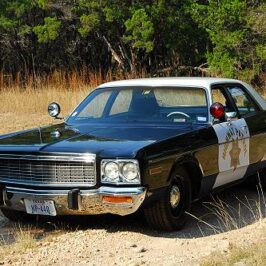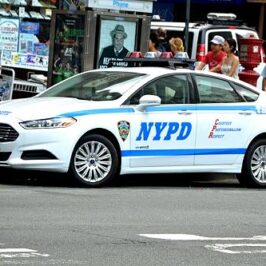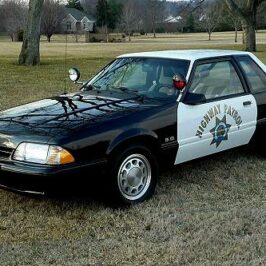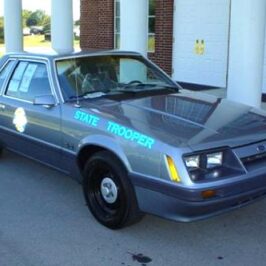What would Ponch and Jon think about Phil Sanchez’s 1986 CHP SSP Mustang?
For one thing, the Mustang coupe would’ve gotten Ponch and Jon out of the rain–on the rare occasion rain falls in Los Angeles. For another, they would’ve appreciated the performance from the Special Service Package–a 5.0L high-output V-8, five-speed transmission, 3.08:1 rearend gears, and plenty of contact patch for acceleration and terrific handling.
The Mustang Special Service Package began as the Mustang Severe Service Package in 1982. In fact, the SSP Mustang was pioneered by the California Highway Patrol (CHP), which employed Chevy Camaro pursuit vehicles from 1979-1981. When the CHP welcomed the Mustang into service, it had a four-barrel 5.0L with a four-speed transmission in a compact two-door sedan package. A deal closer for the CHP was the Mustang’s reliability and price–less than $7,000 per unit, making the Mustang an excellent value for California tax-payers. Of course, they soon came to dread seeing a CHP Mustang in their rearview mirror.
Due to the success of Mustang pursuit vehicles in 1982, Ford decided to create the Mustang Special Service Package. For 1983-1985, the SSP Mustang didn’t change much except for the ’85’s roller-tappet 5.0L and Quadra-shocks, just like GT models.
In the years following, Ford focused on performance and reliability improvements–silicone hoses (blue in color), an improved fan clutch, a 130-amp alternator, a 0-140-mph speed-ometer (later it became 0-160 mph), VASCAR dual-speedometer cables, a remote trunk release, a single-key system, a reinforced floorpan (seat mounts), and 15×7-inch aluminum wheels with Goodyear Gatorback tires beginning in 1985. The SSP’s heater inlet restrictor eventually became standard on all Fox-body Mustangs due to heater core failure. The most significant improvements began for the ’86, with steady development through the end of production in 1993.
It’s important to note that the SSP Mustangs weren’t conceived using off-the-shelf parts. Many components were developed specifically for Special Service use, some finding their way into other heavy-duty applications outside the Mustang carline.
When 5.0L Mustangs received sequential electronic fuel injection for ’86, so did SSP Mustangs. This made the 5.0L H.O. even faster and more reliable. Although horsepower dropped for that year, torque increased significantly.
Not all Special Service Mustangs were stark creatures with taxicab interiors. Some had creature comforts such as power locks and windows, an AM/FM stereo, a tilt wheel, reclining seats, and more. How Special Service Mustangs were ordered depended upon destination, purpose, and agency. Not all of them were police cars. Some were for fire departments and other government agencies. They were also used in the FBI, DEA, and U.S. Air Force, which used them to support U-2 spy plane ground activities.
The CHP may have pioneered the Mustang police car, but word spread quickly and other states began employing Mustangs, including Florida, Utah, Texas, Georgia, Oregon, Washington, and North Carolina.
As SSP Mustangs were phased out of service, most wound up with private buyers after being sold at state and regional auctions. Some vanished into oblivion after being repainted.
Phil Sanchez’s ’86 SSP Mustang doesn’t belong in that group. He bought his LX two years ago, and it hasn’t changed much since it served with the CHP two decades ago. The original 5.0L high-output engine is gone, replaced by a rebuilt 5.0L long-block. It remains a ball to drive because it has all the performance features found in a Mustang GT or LX with high-output power. On the ground are those utilitarian 15×7-inch steel wheels, originally fitted with Goodyear Gatorback tires but now wrapped in replacement 225/60R15 rubber.
Phil’s SSP still has the package shelf lights, twin spotlights, police radios, siren, “whip” antenna, and shotgun. His goal is to keep the car as authentic as possible–strictly for show–to provide enthusiasts and CHP officers something to reminisce about. People frequently walk up to Phil to relate a story about being pulled over by a CHP Mustang. Sometimes, a CHP officer shares a story or two.
Whatever the story, Special Service Mustangs have left a lasting impression, for some more than others. “License and registration, please…”
Photo Gallery
Click the images to enlarge.

